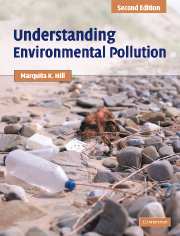Book contents
- Frontmatter
- Contents
- Preface
- Acknowledgements
- List of abbreviations and acronyms
- Chapter 1 Understanding pollution
- Chapter 2 Reducing pollution
- Chapter 3 Chemical toxicity
- Chapter 4 Chemical exposures and risk assessment
- Chapter 5 Air pollution
- Chapter 6 Acidic deposition
- Chapter 7 Global climate change
- Chapter 8 Stratospheric-ozone depletion
- Chapter 9 Water pollution
- Chapter 10 Drinking-water pollution
- Chapter 11 Solid waste
- Chapter 12 Hazardous waste
- Chapter 13 Energy
- Chapter 14 Persistent, bioaccumulative, and toxic
- Chapter 15 Metals
- Chapter 16 Pesticides
- Chapter 17 Pollution at home
- Chapter 18 Zero waste, zero emissions
- Index
- References
Chapter 2 - Reducing pollution
- Frontmatter
- Contents
- Preface
- Acknowledgements
- List of abbreviations and acronyms
- Chapter 1 Understanding pollution
- Chapter 2 Reducing pollution
- Chapter 3 Chemical toxicity
- Chapter 4 Chemical exposures and risk assessment
- Chapter 5 Air pollution
- Chapter 6 Acidic deposition
- Chapter 7 Global climate change
- Chapter 8 Stratospheric-ozone depletion
- Chapter 9 Water pollution
- Chapter 10 Drinking-water pollution
- Chapter 11 Solid waste
- Chapter 12 Hazardous waste
- Chapter 13 Energy
- Chapter 14 Persistent, bioaccumulative, and toxic
- Chapter 15 Metals
- Chapter 16 Pesticides
- Chapter 17 Pollution at home
- Chapter 18 Zero waste, zero emissions
- Index
- References
Summary
“We aren't passengers on Spaceship Earth; we're the crew. We aren't residents of this planet; we're citizens. The difference in both cases is responsibility.”
Astronaut Rusty SchweikartSome pollution problems are daunting. Thus, even before discussing them, this chapter introduces ways to control – better still, not produce – pollution. This chapter also introduces tools that we can use for assistance in moving toward sustainable societies. Section I considers the risks of individual chemicals (to be covered in more detail in Chapter 4). It also introduces comparative risk assessment, which allows us to compare not just the risk of individual chemicals, but the seriousness of various environmental problems: Which pose the greatest risks? Section II addresses how a society can protect its environment. Legislation plays a major role. But, many laws stress trapping pollution once it is produced. A newer paradigm is pollution prevention (P2) or source reduction – changing the process to generate less pollution to begin with. If P2 is not feasible, reuse or recycle are often good options. P2 has limitations too, so Section III introduces industrial ecology (IE), which looks for ways to mesh human activities, industrial and otherwise, into the natural environment. The tools of IE include life-cycle assessment and design for the environment.
SECTION I
Risk assessment
A question that has confronted us for many years is how to evaluate environmental threats. To respond to this question, the tool of risk assessment was developed over a period of decades.
- Type
- Chapter
- Information
- Understanding Environmental PollutionA Primer, pp. 30 - 50Publisher: Cambridge University PressPrint publication year: 2004

